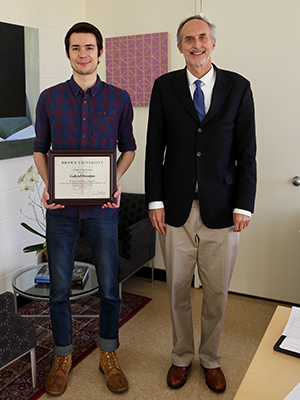Mixing chemical reactions and machine learning for data storage, computing
Gabriel Weedon ’19 wins Doris M. and Norman T. Halpin Senior Capstone Prize for his neural network and chemical computing project.
A project launched almost two years ago by a team of chemists and engineers from Brown University seeks a method to store and manipulate data in ways that have never been done before — by representing data using molecules dissolved in solution. Such a system could have the potential to store terabytes of data in a single flask of liquid.
Under the umbrella of this massive undertaking by some of College Hill’s top campus scientists, Gabe Weedon ’19 found his niche, logging hours in Assistant Professor Jacob Rosenstein’s lab building neural networks using TensorFlow, an end-to-end open source platform for machine learning.
Weedon turned his piece of the project into a senior capstone, simulating chemical-domain neural networks constructed from DNA and enzymes. The work by definition was quite interdisciplinary, requiring him to model chemical reactions, train neural networks under unusual constraints, and to analyze how reaction rate variation and liquid handling operations affect the accuracy of digital image classification.

“Gabe has shown himself to be highly creative, motivated, and able to synthesize ideas from several disciplines,” said Rosenstein. “He has a wide-ranging set of skills and interests in mechanical design, electronic design, computer science, and robotics.” All these skills made him a match for the fall semester opening in the Rosenstein Lab, and Weedon slid over from his previous summer’s desk job of writing code for Brown Computer Science.
After a few months of working together, Rosenstein nominated him, and Weedon was awarded, a 2019 Doris M. and Norman T. Halpin prize for his efforts. Under Rosenstein’s tutelage, Weedon used the funds to purchase chemical supplies, including enzymes, DNA, and consumables, and set aside funding to present the work at an upcoming academic conference.
I could not be happier with everything I’ve been able to accomplish here
“I could not be happier with everything I’ve been able to accomplish here,” Weedon said, launching into a brief description of well plates, DNA storage, and concentration data on his way to creating non-linear classifiers.
“My work is taking the demo framework, and adding chemical reactions with non-linearity. I input experiential parameters into my code, and then train the network in simulation. Theoretically, my output should match what the chemists are doing, up to some level of error.”
For as detailed as he is describing the machine learning way of running neural networks on fluid handling devices, he is also happy to switch gears and talk about the car team. Weedon was in charge of the chassis, suspension, body, brakes, and pedal box of the 2019 Brown car Rhododendron, which finished in 37th place overall at the recent Formula Society for Automotive Engineers competition in Michigan.
The computer engineering concentrator is off to Northeastern University next fall to begin work on his master’s in robotics. It is an impressive resume for a guy who came out of a liberal arts high school in Beverly, Mass. without a lot of STEM opportunities. He is quick to point out that his younger siblings, currently enrolled there, now have a thriving high school robotics team.
“That’s probably what attracted me to Brown the most,” he said. “that the curriculum has allowed me to take about four science and math classes a semester for as long as I’ve been here. I started as a mechanical engineer, but found I also liked the combination of electrical engineering and computer science, so computer engineering seemed like a good compromise.”
A good compromise for all involved, indeed.